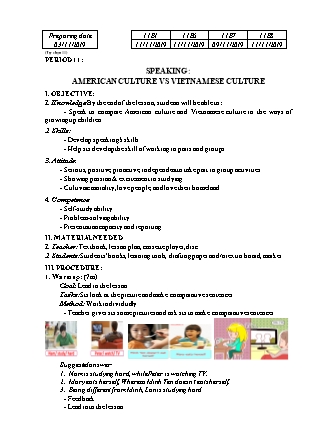Giáo án tự chọn Tiếng Anh Lớp 11 (Thí điểm) - Tiết 11: Speaking "American culture vs vietnamese culture" - Năm học 2019-2020

I. OBJECTIVE:
1. Knowledge: By the end of the lesson, students will be able to:
- Speak to compare American culture and Vietnamese culture in the ways of growing up children.
2. Skills:
- Develop speaking’s skills
- Help sts develop the skill of working in pairs and groups
3. Attitude:
- Serious, positive, proactive, independent to take part in group activities.
- Showing passion & excitement in studying
- Cultivate morality, love people, and love their homeland
4. Competence:
- Self-study ability
- Problem-solving ability
- Presentation capacity and reporting
II. MATERIAL NEEDED
1. Teacher: Textbook, lesson plan, cassette player, disc.
2. Students: Students’ books, learning tools, drafting paper and/or extra board, marker
Preparing date 11B1 11B6 11B7 11B8 03/11/2019 11/11/2019 11/11/2019 09/11/2019 11/11/2019 (Tự chọn 11) PERIOD 11: SPEAKING: AMERICAN CULTURE VS VIETNAMESE CULTURE I. OBJECTIVE: 1. Knowledge: By the end of the lesson, students will be able to: - Speak to compare American culture and Vietnamese culture in the ways of growing up children. 2. Skills: - Develop speaking’s skills - Help sts develop the skill of working in pairs and groups 3. Attitude: - Serious, positive, proactive, independent to take part in group activities. - Showing passion & excitement in studying - Cultivate morality, love people, and love their homeland 4. Competence: - Self-study ability - Problem-solving ability - Presentation capacity and reporting II. MATERIAL NEEDED 1. Teacher: Textbook, lesson plan, cassette player, disc. 2. Students: Students’ books, learning tools, drafting paper and/or extra board, marker III. PROCEDURE: 1. Warmup: (7m) Goal: Lead in the lesson Tasks: Sts look at the picture and make comparative sentences Method: Work individually - Teacher gives sts some pictures and ask sts to make comparative sentences Suggested answer: Nam is studying hard, while Peter is watching TV. Mary eats herself, Whereas Minh Yen doesn’t eats herself. Being different from Minh, Lan is studying hard - Feedback - Lead into the lesson 2. Contents: Teacher’s activities Students’ activities ACTIVITY 1: Discussing to lead-in (10m) Aim: Sts know how to give their opinions Method: Work in groups - Ask sts if they think there are any differences between the ways American and Vietnamese parents raise their children. - Ask them to think about why there are such differences. - Discuss and give the opinions ACTIVITY 2: Read two passages about how American and Vietnamese parents raise their children and answer the questions (10m) Aims: Sts Methods: Work in pairs - Tell Ss to read the texts and see if the information in it matches with their background knowledge. - Ask sts to work in pairs to read again and answer the questions. - Tell Ss to read two passages about how American and Vietnamese parents raise their children and answer the questions - Call on some sts to give their answers. - Ask other to give comments. - Feedback - Read the questions first to find out key words in these questions - Give the answer. - Check and take notes 1. To teach their children to live independent. 2. To protect their children and to provide them with a happy and wealthy childhood. 3. They make them do things such as washing, cleaning and cooking for them from the time they are very small. 4. No. Vietnamese parents seldom ask for their children’s opinions before making family choices. 5. They show respect for them and let them voice their opinions on family issues. 6. After they get married. ACTIVITY 3: Making comparation (15 m) Aims: Sts practice structure to compare 2 cultures Methods: Work in groups - Ask sts to work in groups and make some comparisons between the two countries in terms of raising children. - Tell them to read the texts and see if the information matches with their background knowledge, using while, whereas, different from. - Explain how to use the given words and phrases and give examples before asking sts to make comparisons. - Ask sts to write their comparative sentences on the vice-board. - Hang out the vice-boards on the board and ask sts to give comments. - Feedback - Work in groups to make comparative sentences. - Write the sentences on the vice-boards. - Look at the boards and give comments. - Check and take notes. Expected answers: 1. American parents’ most important task is to teach their children to live independently, while Vietnamese parents think their most important role is to protect their children and provide them with a happy and wealthy childhood. 2. Parents always show respect for their children and let them voice their opinions on issues, whereas Vietnamese parents rarely ask for their children’s opinions before making family choices. 3. When American children finish school, most of them will move out of the family home and start a truly independent life, whereas Many Vietnamese parents want their children to live with them in the same roof. 4. While most Vietnamese children sleep with their parents until they go primary school, most American children get their own rooms from an early age. 3. Consolidation and homework a. Consolidation: (2m) - Teacher summaries main points of the lesson - Students listen and add some more points b. Homework: (1m) - Do the task again - Prepare the next lesson at home.
Tài liệu đính kèm:
 giao_an_tu_chon_tieng_anh_lop_11_thi_diem_tiet_11_speaking_a.docx
giao_an_tu_chon_tieng_anh_lop_11_thi_diem_tiet_11_speaking_a.docx



